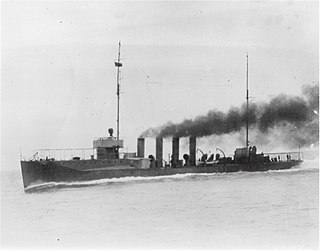Related Research Articles

The first USS Whipple (DD-15) was a Truxtun-class destroyer in the United States Navy, named for Abraham Whipple.

USS Beale (DD-40), a Paulding-class destroyer served in the United States Navy during World War I and later with the United States Coast Guard. She was the first ship of the Navy to be named for Edward Fitzgerald Beale.

USS Taylor (DD-94) was a Wickes-class destroyer built in 1918 for the United States Navy, which saw service in World War I and the years following. She was named for Rear Admiral Henry Taylor.

USS Hull (DD-7) was a Hopkins-class destroyer, which was a sub-class of the Bainbridge-class destroyer, in the United States Navy, the second ship named for Commodore Isaac Hull.

The second USS Blakeley (DD–150) was a Wickes-class destroyer in the United States Navy, named for Captain Johnston Blakeley.

The second USS Bagley (DD–185) was a Wickes-class destroyer in the United States Navy following World War I. She was renamed USS Doran and later transferred to the Royal Navy as HMS St. Mary's (I-12), a Town-class destroyer.

The first USS Haraden (DD–183) was a Wickes-class destroyer in the United States Navy in the period following World War I. She was later transferred to the Royal Canadian Navy as HMCS Columbia, as a Town-class destroyer.

The third USS Lawrence (DD-8) was a Lawrence-class destroyer, which was a sub-class of Bainbridge-class destroyer, in the United States Navy. She was named for Captain James Lawrence.

The first USS Stewart (DD-13) was a Bainbridge-class destroyer in the United States Navy. She was named for Rear Admiral Charles Stewart.

USS Smith (DD–17) was the lead ship of Smith-class destroyers in the United States Navy. She was the first ship named for Lieutenant Joseph B. Smith. Entering service in 1909, the destroyer was placed in reserve in 1912. She was reactivated for World War I and, following the war, was used as a test ship for aerial bombing. In 1921, the vessel was sold for scrapping.

The O'Brien class of destroyers was a class of six ships designed by and built for the United States Navy shortly before the United States entered World War I. The O'Brien class was the third of five classes of destroyers that were known as the "thousand tonners", because they were the first U.S. destroyers over 1,000 long tons (1,016 t) displacement.

USS Mason (DD-191) was a Clemson-class destroyer in the United States Navy during World War II. She was later transferred to the Royal Navy as HMS Broadwater (H81).

The Federal Shipbuilding and Drydock Company was a United States shipyard, active from 1917 to 1948. It was founded during World War I to build ships for the United States Shipping Board. During World War II, it built ships as part of the U.S. Government's Emergency Shipbuilding program. Operated by a subsidiary of the United States Steel Corporation, the shipyard was located at Kearny Point where the mouth of the Hackensack River meets Newark Bay in the Port of New York and New Jersey. The shipyard site is now part of River Terminal, a massive distribution facility that is partially a foreign trade zone.
USS SC-255, sometimes styled as either Submarine Chaser No. 255 or S.C.-255, was an SC-1-class submarine chaser built for the United States Navy during World War I. Like most members of her class, she was not named and known only by her designation.

USS SC-48, sometimes styled as either Submarine Chaser No. 48 or S.C.-48, was an SC-1-class submarine chaser built for the United States Navy during World War I. Like most members of her class, she was not named and known only by her designation.

USS SC-49, prior to July 1920 known as USS Submarine Chaser No. 49 and USS S.C. 49, was an SC-1-class submarine chaser built for the United States Navy during World War I.

USS SC-1, prior to July 1920 known as USS Submarine Chaser No. 1 or USS S.C. 1, was an SC-1-class submarine chaser built for the United States Navy during World War I.

USS SC-26, until July 1920 known as USS Submarine Chaser No. 26 or USS S.C. 26, was an SC-1-class submarine chaser built for the United States Navy during World War I.

USS SC-35, until July 1920 known as USS Submarine Chaser No. 35 or USS S.C. 35, was an SC-1-class submarine chaser built for the United States Navy during World War I.

USS SC-37, until July 1920 known as USS Submarine Chaser No. 37 or USS S.C. 37, was an SC-1-class submarine chaser built for the United States Navy during World War I.
References
- ↑ The Federal Reporter, Vol. 138, p. 586
- ↑ "A Message to Industrial Philadelphia". Evening Public Ledger. Philadelphia. April 16, 1919.
- 1 2 "Just a few of the War Craft that have been Discarded". Evening Public Ledger. Philadelphia. July 8, 1922. p. 22.
- This article incorporates text from the public domain Dictionary of American Naval Fighting Ships .
| | This article about an American businessperson born in the 1860s is a stub. You can help Wikipedia by expanding it. |